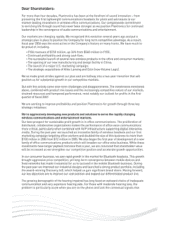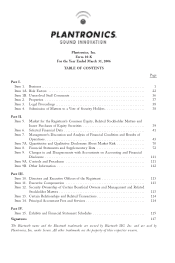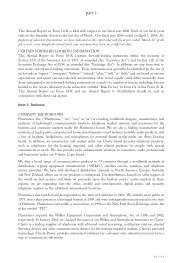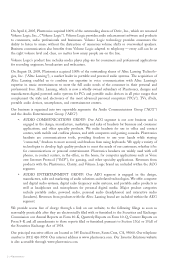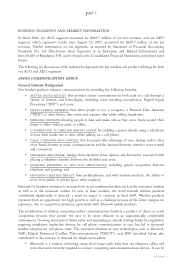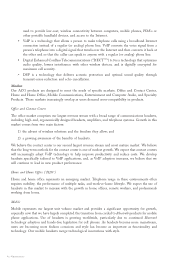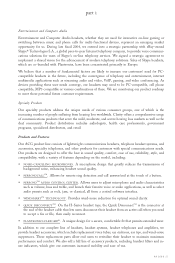Plantronics 2006 Annual Report Download - page 9
Download and view the complete annual report
Please find page 9 of the 2006 Plantronics annual report below. You can navigate through the pages in the report by either clicking on the pages listed below, or by using the keyword search tool below to find specific information within the annual report.
part i
BUSINESS SEGMENTS AND MARKET INFORMATION
In fiscal 2006, our ACG segment accounted for $629.7 million of our net revenues, and our AEG
segment, which represents results since August 18, 2005, accounted for $120.7 million of our net
revenues. Further information on our segments, as required by Statement of Financial Accounting
Standards No. 131 (Disclosures about Segments of an Enterprise and Related Information) and
Item 101(b) of Regulation S-K can be found in the Consolidated Financial Statements and related notes
herein.
The following are discussions of the industry background, the key markets and product offerings for both
our ACG and AEG segments.
AUDIO COMMUNICATIONS GROUP
General Industry Background
Our headset products enhance communications by providing the following benefits:
)
BETTER SOUND QUALITY
that provides clearer conversations on both ends of a call through a
variety of features and technologies, including noise-canceling microphones, Digital Signal
Processing (‘‘DSP’’), and more;
)
MULTI
-
TASKING BENEFITS
that allow people to use a computer, a Personal Data Assistant
(‘‘PDA’’) or other device, take notes and organize files while talking hands-free;
)
WIRELESS FREEDOM
allowing people to take and make calls as they move freely around their
home or office without cords or cables;
)
CONTRIBUTING TO GREATER DRIVING SAFETY
by enabling a person already using a cell phone
to have both hands free to drive while talking on a cell phone;
)
VOICE COMMAND AND CONTROL
that let people take advantage of voice dialing and/or other
voice-based features to make communications and the human/electronic interface more natural
and convenient;
)
PROVIDING ERGONOMIC RELIEF
from repetitive stress injuries and discomfort associated with
placing a telephone handset between the shoulder and neck;
)
ENABLING EMERGING PC AND VOIP APPLICATIONS
, including speech recognition, Internet
telephony and gaming; and
)
PROVIDING GREATER PRIVACY
than speakerphones, and with wireless products, the ability to
move from public to private space when required.
Demand for headsets continues to increase both in our traditional markets such as the enterprise markets
as well as in the consumer market. In each of these markets, the trend towards wireless products
contributed significantly to demand, a trend we expect to continue in fiscal 2007. Wireless products
represent both an opportunity for high growth as well as a challenge because of the lower margins we
experience due to competitive pressures, particularly with Bluetooth mobile products.
The proliferation of desktop computing makes communications headsets a product of choice in many
occupations because they permit the user to be more efficient in an ergonomically comfortable
environment. Growing awareness of driver safety and impending or already existing hands-free legislation
requiring mandatory hands-free devices for cell phone communications in cars, has led to increased
headset adoption for cell phone users. The increased adoption of new technologies, such as Bluetooth,
VoIP, Digital Enhanced Cordless Telecommunications (‘‘DECT’’), and DSP described below, also
contributed to the increase in demand for telephone headsets:
)Bluetooth is a wireless technology using short-range radio links that can eliminate cables and
wires that were formerly required to connect computing and communications devices. It can be
AR 2006 ⯗3


